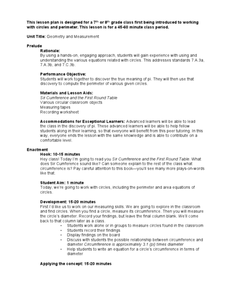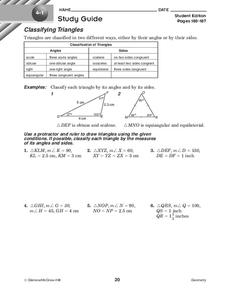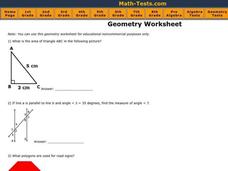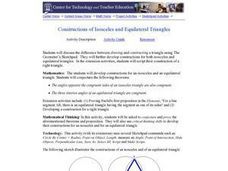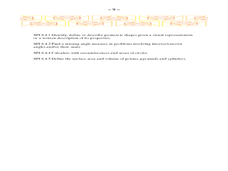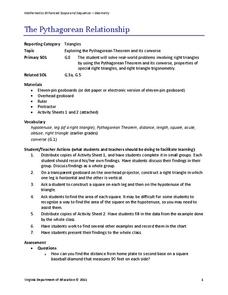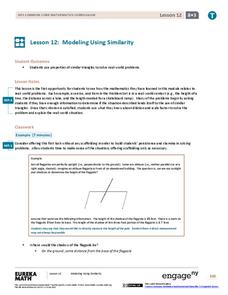Curated OER
Radian Measure
Young mathematicians identify central angles, arcs and radius of circles in this pre-calculus lesson. They identify the proportion of the circle based on its radius while they convert between degrees and radians measurements.
Curated OER
Corresponding Parts of Similar Triangles
Here is a lesson that has learners take a look at corresponding parts of similar triangles, ratios of similarity, reductions and enlargements. They'll manipulate the scale factor (r) to observe the changes in similar triangles and then...
Curated OER
Angles in Standard Positions
Young scholars identify positive and negative angles using the Unit Circle. In this pre-calculus lesson, students identify the different angles on a unit circle using the coordinate plane and the four different quadrants as a guide. They...
Curated OER
Reference Angles
Learn how to measure the reference angles in degrees and radians. Students find reference angles that are coterminal with a given angle.
Curated OER
Triangle Fundamentals Multiple Choice
In this triangle fundamentals worksheet, students identify possible side lengths of triangles. The first three problems give measurements of the sides, students select the combination that is possible in a triangle. The final three...
Curated OER
The Triangle Midsegment Theorem
In this geometry worksheet, 10th graders identify the vocabulary associated with the Triangle Midsegment Theorem and solve problems in which they find the size of a missing angle or segment. The one page worksheet contains nineteen...
Curated OER
Congruence of Triangles
In this congruence of triangles worksheet, 10th graders solve and complete 10 different problems that include measuring the congruence of various triangles. First, they determine the length of a third side of an isosceles triangle. Then,...
Curated OER
Geometry and Measurement
Middle schoolers view a right triangle displayed by the teacher. Students measure legs and the interior angles of the triangle. They look for a pattern or relationship between the legs and angles. Middle schoolers use pegboards and...
Curated OER
Try These Angles! Exploring Angles
In this angles worksheet, learners answer multiple choice questions about different types of angles in shapes. Students complete 10 questions.
Curated OER
Triangles
In this triangles worksheet, students solve for the missing angles and missing sides on the triangles given. Students complete 12 problems total.
Curated OER
Classifying Triangles
In this classifying triangles worksheet, 10th graders solve 6 different problems related to the classification of triangles either by their angles or by their sides. First, they use a protractor and a ruler to draw triangles using the...
Curated OER
Triangles
In this triangles worksheet, 10th graders solve 10 different problems that include determining the measurement of various angles. First, they determine the area of a triangle illustrated on the sheet. Then, students use the picture to...
Curated OER
A Special Relationship
Learners discover the relationships of the lengths of the sides of right triangles and right triangles using a series of drawings on dot paper. They investigate and solve problems of standard (customary and metric units) and non-standard...
Curated OER
Constructions of Isosceles and Equilateral Triangles
Students explore the difference between drawing and constructing a triangle utilizing The Geometer's Sketchpad on the computer. They create, develop and script constructions for both isosceles and equilateral triangles. Each student has...
Curated OER
Geometry and Measurement Pre-Test
Use this comprehensive pre-instruction assessment tool to focus your teaching where your class needs it most. Multiple choice questions assess your budding geometers' conceptual and vocabulary knowledge, but they do not solve any...
Inside Mathematics
Rhombuses
Just what does it take to show two rhombuses are similar? The assessment task asks pupils to develop an argument to show that given quadrilaterals are rhombuses. Class members also use their knowledge of similar triangles to show two...
EngageNY
Using Trigonometry to Determine Area
What do you do when you don't think you have enough information? You look for another way to do the problem! Pupils combine what they know about finding the area of a triangle and trigonometry to determine triangle area when they don't...
EngageNY
From Circle-ometry to Trigonometry
Can you use triangles to create a circle? Learners develop the unit circle using right triangle trigonometry. They then use the unit circle to evaluate common sine and cosine values.
Willow Tree
Ratios and Proportions with Congruent and Similar Polygons
Investigate how similar and congruent figures compare. Learners understand congruent figures have congruent sides and angles, but similar figures only have congruent angles — their sides are proportional. After learning the...
Virginia Department of Education
The Pythagorean Relationship
Add up areas of squares to discover the pythagorean relationship. Small groups create right triangles with squares along each side. They calculate the areas of each square and notice the relationship. Groups construct other types of...
Illustrative Mathematics
Bank Shot
Young geometers become pool sharks in this analysis of the angles and lengths of a trick shot. By using angles of incidence and reflection to develop similar triangles, learners plan the exact placement of balls to make the shot....
Arizona Department of Education
Area and Perimeter of Regular and Irregular Polygons
Extend young mathematicians' understanding of area with a geometry lesson on trapezoids. Building on their prior knowledge of rectangles and triangles, students learn how to calculate the area of trapezoids and other...
EngageNY
Modeling Using Similarity
How do you find the lengths of items that cannot be directly measured? The 13th installment in a series of 16 has pupils use the similarity content learned in an earlier resource to solve real-world problems. Class members determine...
Noyce Foundation
Which is Bigger?
To take the longest path, go around—or was that go over? Class members measure scale drawings of a cylindrical vase to find the height and diameter. They calculate the actual height and circumference and determine which is larger.









